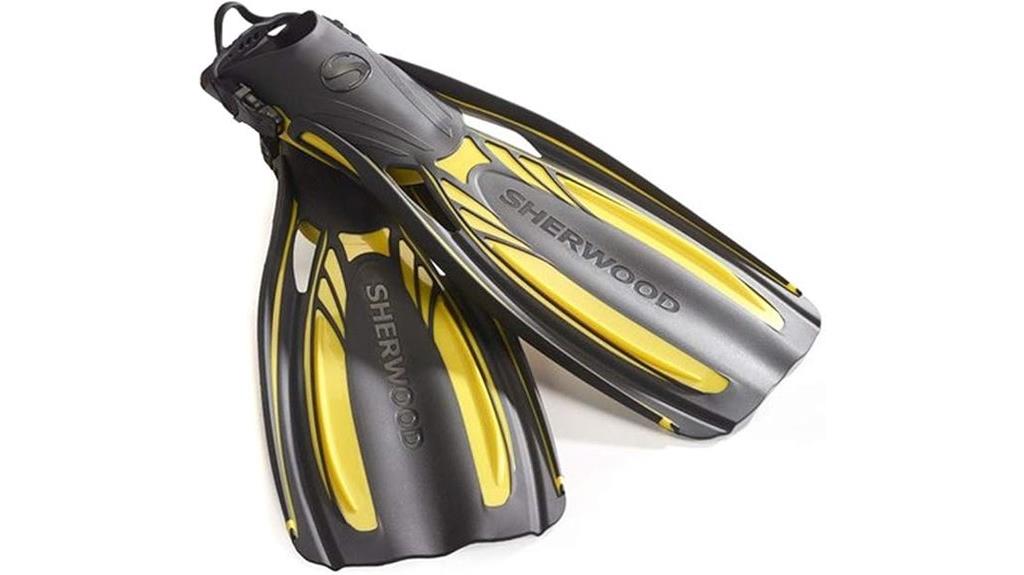Essential scuba gear encompasses key components for underwater navigation.
The dive mask ensures optimal visibility, while the primary and octopus regs control airflow from the cylinder. A set of dive fins enables efficient propulsion, and the BCD manages neutral buoyancy.
Additional gear includes exposure protection like a wetsuit or drysuit, weight systems, dive computer, pressure gauge, and depth indicator.
These tools form the fundamental setup for subsurface exploration.
Key Takeaways
- Scuba mask and reg setup convert cylinder air to ambient pressure gas supply while maintaining underwater visibility.
- Diving fins (split or blade design) with adjustable foot pockets provide underwater propulsion and maneuverability.
- Thermal protection gear (wetsuit/drysuit) shields against heat loss based on water temp and dive conditions.
- BCD or wing system manages buoyancy through bladder inflation/deflation, doubling as tank harness.
- Dive computer monitors bottom time, NDLs, ascent rate, and displays vital dive parameters.
Essential Components of a Scuba Diving Mask
A dive mask is the diver’s viewport to the subsea realm. Its core structure consists of a reinforced frame housing a tempered glass lens for optical clarity. Black silicone skirts are often preferred by divers as they reduce glare and improve focus underwater.
The watertight barrier relies on a low-pressure skirt, typically crafted from hypoallergenic silicone or neoprene compounds. The mask band, engineered from similar materials, ensures optimal positioning on the diver’s dome. Contemporary designs range from low-volume masks to integrated systems that mesh with rebreathers.
The mask’s purge valve and nose pocket allow for mask clearing and equalizing maneuvers during depth changes, essential for preventing mask squeeze and maintaining neutral pressure.
Understanding the Role of Regulators in Diving
Dive regs transform compressed gas from cylinders into ambient-pressure breathing mix. The setup works through two core mechanisms. Safe underwater breathing requires proper regulator maintenance and inspection before every dive.
| Component Type | Primary Function |
|---|---|
| First Stage | Reduces tank pressure to 10-12 atm |
| Second Stage | Delivers breathable air at ambient pressure |
| Octopus | Links to SPGs and redundant air delivery |
Regs come in balanced piston or diaphragm configurations. Both incorporate SPGs and octos for redundancy. Environmental factors like temperature and breathing resistance influence reg selection for specific dive conditions.
Choosing the Right Fins for Your Dive
Fin selection is essential for aquanauts, directly affecting buoyancy control and trim underwater. Consider these elements when gearing up:
Materials & Construction
- Modern tech: composite, carbon fiber, and Innegra polymers
- Split fins vs paddle fins for varying thrust patterns
- Spring straps or traditional rubber straps for secure fit
Application-Specific Design
- Recreational fins: medium-length blades for reef exploration
- Tech diving fins: sturdy blades for frog kicks and back finning
- Free diving: extended blade length for sustained propulsion
Fit & Function
- Heel retention systems for neutral buoyancy position
- Boot compatibility with foot pocket volume
- Power-to-weight ratio matching diver’s physique
Wide Feet Considerations for Fins:
- Select fins with broader foot pockets designed for wide feet
- Look for adjustable straps or expandable materials
- Check for “wide” or “comfort fit” designations
- Consider split fins which often have roomier foot pockets
- Avoid narrow European-style foot pockets
Choosing fins with proper stiffness levels based on your weight ensures optimal performance and reduces fatigue during dives.
The fin choice influences propulsion efficiency, air consumption, and bottom time on each dive.

Wetsuit vs. Drysuit: Protection and Insulation
Exposure protection gear like wetsuits and drysuits equip aquanauts with thermal barriers in different dive conditions. Wetsuits trap a water film between neoprene and the epidermis, creating thermal insulation for recreational diving above 21°C. Drysuits seal out H2O completely, letting bubble chasers layer up with undergarments for deeper immersions and cold water penetration below 15°C. These exposure suits serve distinct missions – from reef exploration to ice diving – based on their construction and insulation methods. Drysuits maintain consistent buoyancy control throughout depths, while wetsuits compress and lose buoyancy as divers descend.
Temperature Range Applications
Water temps dictate exposure protection for aquanauts. Above 60°F (15.6°C), wetsuits serve as adequate thermal barriers, with thickness specs varying by conditions. Waters above 82.4°F require minimal coverage, while temps between 71.6°F and 75.2°F demand 3mm full coverage. These choices also depend on individual tolerance levels that can vary significantly among divers.
Sub-60°F (15.6°C) operations call for drysuits, essential for submersion below 50°F (10°C). These shells, paired with base layers, create an air barrier system. Unlike neoprene’s water insulation method, drysuits maintain waterproof seals, making them standard kit for tech diving, ice penetration, and extended bottom time in demanding environments.
Construction and Material Differences
The fundamental composition of exposure protection gear relies on distinct materials and assembly methods. Wetsuits incorporate neoprene – a nitrogen-filled foam rubber that traps a water layer for thermal regulation. Modern wetsuit manufacturing increasingly uses limestone-based neoprene for environmental sustainability. Drysuits employ membrane shells like Gore-Tex or trilaminate materials, creating a waterproof barrier.
| Feature | Wetsuit | Drysuit |
|---|---|---|
| Primary Material | Neoprene foam | Waterproof layers |
| Insulation Method | Water trapped between suit and skin | Air space with thermal underlayers |
| Seam Construction | Blind stitch, flatlock, or fluid weld | Taped and sealed layers |
The build methods match their dive functions: wetsuits utilize stretch panels and anatomical cuts for mobility, while drysuits feature vulcanized seals and pressure-tested joints. Each employs specific seam technology – from fluid-sealed neoprene to hydrophobic taping – to maintain watertight integrity.
The BCD: Your Underwater Buoyancy Control System
The Buoyancy Control Device (BCD) is essential gear for divers to maintain neutral buoyancy underwater. This life support equipment combines an air cell with inflate/deflate mechanisms and dump valves. Gas volume adjustments are critical for maintaining proper buoyancy as depth changes during a dive.
BCDs come in jacket-style, wing, or hybrid configurations, each utilizing compressed air for buoyancy adjustments. Core features include the LPI (low-pressure inflator), OPR valve for overpressure protection, and dump valves for venting. Divers should evaluate lift capacity, trim characteristics, and D-ring placement when choosing a BCD that matches their diving needs.
Air Tanks and Cylinder Safety
Scuba cylinders demand strict adherence to safety protocols to ensure reliable operation during dives. These metal vessels store compressed breathing gas that keeps aquanauts alive underwater. Modern scuba diving relies on open-circuit systems that release exhaled gas directly into the water.
- Annual VIP (Visual Inspection Program) checks help detect tank degradation and rust formation
- Store bottles upright with minimal working pressure to prevent tank fires and valve damage
- During transportation, secure tanks horizontally to shield DIN or yoke valves from impact
- Source air fills from certified dive operators using filtered compressor systems
- Maintain positive pressure underwater to prevent backflow into the cylinder
Emergency Gear and Safety Equipment
Dive kit safety gear includes surface markers (SMBs), air horns, and PLBs for emergency signaling topside. Essential rescue equipment comprises DAN O2 units, safety sausages, line cutters, and grab lines. A reliable buoyancy control device with sufficient lift capacity is crucial for maintaining stability during rescue operations. These tools integrate with emergency comms to enable swift response during sub-surface or surface incidents.
Essential Emergency Signal Devices
Dive safety hinges on reliable signaling gear that works both subsurface and topside. Aquatic explorers rely on multiple devices to mark position and call for assistance. Small and lightweight devices enable quick access during emergencies.
- SMBs and safety sausages deploy at safety stops, marking ascent points
- EPIRBs and PLBs broadcast distress signals via satellite networks
- Noisemakers: tank tappers, Dive Alert® systems, and whistles for surface signals
- Torch signals: LED strobes and backup dive lights with SOS functions
- Underwater acoustic devices for buddy communication at depth
Regular gear checks and deployment drills maintain equipment readiness for emergencies.
Critical First-Aid Items
Aqua pros know proper first-aid gear is as vital as their BC or regs. A standard med kit contains CPR barrier devices, waterproof dressings, sterilizing wipes, and antibiotic salves for wound care. The kit’s chlorhexidine gluconate wipes provide immediate germicidal action for preventing infections at the dive site. Emergency supplies include space blankets for temp regulation, compression bandages for bleeder control, and basic med implements.
For aquatic incidents, bubble-watchers pack neutralizers for marine stings, pure H2O for general treatment, and pain meds. Support gear includes full-face masks for buddy comms, backup air delivery systems, and essential spares like fin buckles and mouthpiece holders that can make the difference during subsurface situations.
Dive Computer Technology and Usage
Dive computers represent a key safety innovation in recreational and technical diving. These wrist-mounted units process essential metrics during submersion, allowing aquanauts to execute their dives within established parameters. Modern dive computers utilize ambient pressure transducers to measure depth accurately.
- Computes NDL (no-decompression limits) and deco stops in real-time
- Tracks bottom time, max depth, and vertical velocity
- Triggers safety warnings through haptic and LED signals
- Displays tank PSI and PO2 readings on air-integrated models
- Handles gas switches between back gas and stage bottles
The unit’s firmware employs decompression modeling to analyze ambient atmospheres and tissue loading, providing critical data while submerged. Proper upkeep and operator proficiency ensure dependable functionality.


